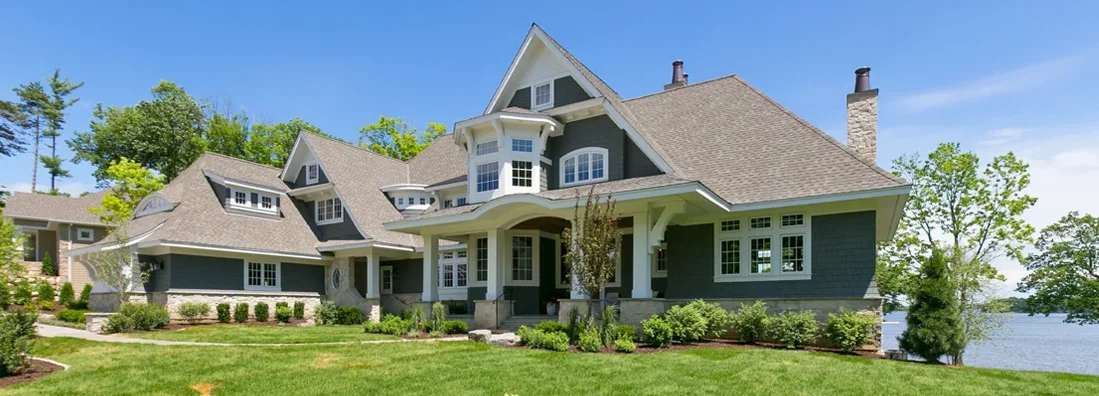HO-3 Insurance Policy Explained
Understanding the most popular type of homeowners insurance you never knew the name of.

Jeff Green has held a variety of sales and management roles at life insurance companies, Wall street firms, and distribution organizations over his 40-year career. He was previously Finra 7,24,66 registered and held life insurance licenses in multiple states. He is a graduate of Stony Brook University.

Most of the homeowners you know, including yourself, probably have an HO-3 home insurance policy. That’s because an HO-3 policy is one of the most popular types of homeowners insurance for people who own (not rent) their single-family home, multi-family home, or townhome. It also gives you more coverage than an HO-1 or HO-2.
Insurance agents typically suggest that homeowners purchase, at minimum, an HO-3 homeowners policy. The reason for this is that an HO-3 insurance policy will provide coverage for your property against all risks, except those explicitly excluded in the policy documents.
What Is an HO-3 Insurance Policy?
HO-3 homeowners insurance is the most common home insurance coverage type you can find, and every private property insurance company offers it. This coverage protects your home and your belongings, and covers liability for injury and property damage caused by you and the residents in your household — even your dog.
One thing to note is that an HO-3 homeowners insurance policy provides different coverage than for your belongings. Your home and any structures on it are covered under "open perils," meaning your policy will protect against any disaster unless it's excluded in your policy. But your belongings are only covered under "named perils," meaning your policy will only protect them against specifically listed losses.
If you own your single-family home, multi-family home, or townhouse, you are eligible to purchase HO-3 coverage.
What Does an HO-3 Policy Cover?
Imagine you just bought your first house and you're all set to move in. You've got your furniture, clothes, and all your favorite things. But what if something goes wrong? What if a tree falls on your roof, or a fire breaks out, or a burglar decides to pay you a visit? What happens if a person coming to visit trips on your new carpet and breaks a leg? That's where HO-3 homeowners insurance comes in.
An HO-3 homeowners insurance policy provides coverage that protects your home, personal belongings, and financial responsibility if you or members of your household cause bodily injury or property damage to others. It includes six key coverages that are standard in every HO-3 policy.
Dwelling Coverage
Your HO-3 policy's dwelling coverage covers your home and any attached structures like a porch or garage, up to the replacement cost of the policy. Just to clarify, the replacement cost and market value of your home aren't the same thing. The market value includes the value of your land and home, while the replacement cost is specifically intended to help you rebuild if your home is destroyed.
Other Structures Coverage
Anything separate from your home, like detached garages, driveways, pools, sheds, and fences, are usually covered under the "other structures" part of your policy. Coverage is typically capped at 10% of your dwelling limit. So, if your dwelling coverage is $250,000, coverage to replace or repair a separate structure on your property would pay out up to $25,000 after your deductible.
Personal Property Coverage
Your personal property coverage protects your clothing, furniture, television, and other personal belongings up to the coverage limit, typically 50% of your dwelling limit. It’s important to note that coverage for these items is only provided in the event of losses resulting from specifically listed incidents, known as named perils.
Typically, personal property coverage is offered at either actual cash value or replacement value. In the case of actual cash value, the coverage considers depreciation and wear and tear when calculating the amount to be paid. Replacement value coverage provides the full cost required to replace the lost or damaged items.
Loss of Use
If your home suffers significant damage, your loss of use coverage can help cover the cost of temporary housing and relocation expenses while it's being fixed up. This coverage can help with expenses like hotel bills, restaurant meals, pet boarding, and more. The coverage limit is usually 30% of your dwelling coverage.
Personal Liability
Personal liability coverage under an HO-3 policy protects your finances if you or members of your household are found at fault for damage to someone else's property or cause injury to another person. It has coverage limits typically ranging from $100,000 to $500,000, offering coverage for legal fees, court settlements, and other related costs.
Medical Payments to Others
Medical payments coverage, included in an HO-3 policy's liability coverage, offers financial protection for medical expenses incurred when a visitor is injured at your house or if you or members of your household cause injury to another person. Coverage can pay for hospital fees, ambulance charges, dental and surgical costs, funeral services, and other medical expenses. The coverage limit for medical payments typically ranges from $1,000 to $5,000.
What Perils Are Covered by HO-3 Insurance?
An HO-3 insurance policy provides coverage for both your home and personal belongings, but in different ways. The physical structure of your home and any attached structures, such as fences or detached garages, are protected against a wide range of incidents, known as "open perils," with the exception of those specifically excluded in your policy. Given the significant investment you have in your home, it is highly recommended to opt for open peril coverage for your dwelling.
On the other hand, the contents of your home, including your personal items, are only covered in the case of specific incidents known as "named perils."
Named Perils
The coverage for your personal belongings is limited to the risks explicitly mentioned in the policy. These 16 named perils are:
- Fire and lightning
- Explosions
- Smoke
- Hail and wind
- Malicious mischief and vandalism
- Theft
- Volcanic eruptions
- Falling objects
- Freezing of household systems
- Weight of sleet, snow, and ice
- Accidental flooding from stream or water
- Sudden and accidental tearing apart, burning, cracking or bulging of household systems
- Sudden and accidental damage from artificially generated electrical current
- Riots and civil commotion
- Aircraft
- Vehicles
Open Perils
While HO-3 insurance covers your home on an open-perils basis, it does not cover everything. Common exclusions in open peril coverage include:
- Freezing pipes and systems in vacant dwellings
- Damage to foundations or pavements from ice and water weight
- Theft from a dwelling under construction
- Vandalism to vacant dwellings
- Latent defects, corrosion, industrial smoke, and pollution
- Settling, wear and tear
- Pets, other animals and pests
- Weather conditions that aggravate other excluded causes of loss
- Government and association actions
- Defective construction, design and maintenance
Are There HO-3 Insurance Policy Exclusions?
HO-3 policies are quite popular, but they have a downside: named-peril coverage for personal property. While you're covered against a lot of perils, you have to prove that the damage was caused by one of those perils in order to make a claim. This can sometimes slow down the claims process, depending on the situation.
One thing to keep in mind is that floods and earthquakes are usually not covered by most home insurance policies. If you're looking to protect your home against these types of events, you'll probably need to buy a separate flood or earthquake insurance policy. Additionally, there are a few other perils that are typically excluded from all home insurance policies, so it's important to familiarize yourself with these exclusions.
- Earthquake, mudflow, and sinkhole (called “earth movement”)
- Demolition of your residence ordered by a court and to bring it into code
- Demotion or seizure of property by a public authority or government agency
- Water damage from water seepage under the foundation, sewer backup, flood
- Power failure
- War
- Neglect
- Mold
Note: Some policies allow you to add limited coverage for mold damage and earthquake insurance to a policy. An independent agent can help guide you.
Who Needs HO-3 Insurance Coverage?
HO-3 insurance coverage is ideal for homeowners who want comprehensive coverage for their homes and personal property. It’s also recommended for homeowners who want peace of mind knowing that they have protection against unexpected events.
If you're a homeowner, it's important to consider the financial risks associated with these events and make sure that you have the right insurance coverage in place to protect your investment. There are several types of home insurance coverage available, and an independent insurance agent can work with you to find the best coverage for your needs and budget.
Are There Other Types of Home Insurance?
There are numerous types of home insurance policies available, each providing a unique set of coverage options. Some of the most common policy types include:
- HO-1: This is the simplest form of home insurance, covering the home's structure, attached structures, appliances, and permanently installed items like carpeting. Claims are paid on a named-perils basis.
- HO-2: This policy offers everything in an HO-1 policy, but also includes limited liability protection and coverage for detached structures, personal property, loss of use, and more. Claims are paid on a named-perils basis.
- HO-4: This policy type is designed for renters, offering coverage for contents and liability protection, as well as additional living expenses and medical payments if a guest is injured in your home. Claims are paid on a named-perils basis and there is no coverage for the home's structure.
- HO-5: This policy is similar to an HO-3 but offers coverage for both the home and personal property on an open-perils basis, and may include extra coverage for items like jewelry. This policy is often offered to those with high-value homes.
- HO-6: This policy is intended for condo unit owners and some townhome owners and covers the interior of the unit. The home's exterior is covered by a separate HOA master policy. Claims are paid on a named-perils basis, much like an HO-3 policy.
- HO-7: Mobile, modular, and manufactured homes are covered by an HO-7 policy, which offers coverage similar to an HO-3 policy, with the structure covered on an open-perils basis and contents insured on a named-perils basis.
- HO-8: This policy type is typically used for historic or architecturally significant homes that are difficult or impossible to replace. Coverage is similar to an HO-3 policy and claims are paid on a named-perils basis.
FAQ about HO-3 Insurance
HO-3 insurance offers comprehensive protection for your home, encompassing all essential coverage types like dwelling, personal property, other structures, liability, medical payments, and coverage for additional living expenses. Your home's physical structure is insured against open peril under an HO-3 policy, while your personal belongings are covered on a named-perils basis.
If you're looking for HO-3 insurance, you've got plenty of options. Many private insurance companies sell this type of coverage. Whether you want to go with a big national company or a local one, the choice is yours. And if you already have car insurance with a certain provider, buying home insurance from the same company could even get you a bundle discount. An independent insurance agent can help you find the right coverage and answer any questions you might have.
HO-3 insurance costs can vary greatly from person to person. A lot of factors play into what you'll end up paying, like where you live, your age, past claims, the age and size of your home, and more. Because of all these factors, it's smart to compare insurance quotes from different providers to see who can offer you the best deal.
HO-3 insurance does not include protection against flood damage. Homeowners who want to be covered for this type of event will typically need to purchase separate flood insurance.
HO-3 insurance doesn't provide coverage for earthquakes. If you want to be protected from this type of disaster, you'll usually need to buy separate earthquake insurance.
The main difference between an HO-3 policy for a stand-alone home and an HO-6 policy for a condo is that, while an HO-3 policy provides coverage for the physical structure of your home, an HO-6 policy only offers coverage for the interior of your condo unit. This means that the structure of the building itself is not covered under an HO-6 policy.
HO-3 insurance is a type of special form insurance. In contrast, broad form home insurance (HO-2) only provides coverage for your home and personal belongings, and typically operates under a named-perils policy. This limited coverage and the absence of liability protection make broad form policies an unpopular choice, often not recommended or accepted by mortgage lenders.
On the other hand, HO-3 special form policies offer more comprehensive protection, covering your home, belongings, and liability with a broader range of covered perils than broad form insurance.
https://www.iii.org/article/are-there-different-types-policies
https://www.iii.org/article/am-i-covered
https://www.thezebra.com/homeowners-insurance/policies/what-is-ho-3-insurance-policy/
